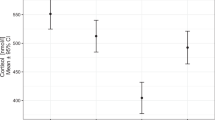Abstract
Utilization of the daily rhythm of ACTH secretion was assessed as a measure of the adequacy of replacement therapy in primary chronic adrenal failure (PCAF; Addison's disease) with glucocorticoids (GC) by assaying plasma ACTH by radioimmunoassay every 4 h for one day in three groups of patients. Patients of group 1 had PCAF (n = 14) and received replacement therapy consisting of prednisolone (5 mg at 09:00 and 2.5 mg at 14:00) and group 2 patients received dexamethasone (0.5 mg at 23:00) in combination with prednisolone (2.5 mg at 14:00). All patients with PCAF also received 0.005–0.01 mg/day of 9α-fluorocortisol. The control group consisted of 14 healthy volunteers. Both types of replacement therapy resulted in high levels of variability in ACTH levels as compared with that in normal subjects. The areas under the curve (AUC) of the ACTH concentration over one day were not significantly different between groups 1 and 2 or between group 2 and controls. The AUC of ACTH in group 1 was significantly larger than that in controls. The mean ACTH concentration in group 1 at 07:00 and 11:00 was significantly greater than those in the other two groups. The daily rhythm of ACTH was generally closer to normal in patients given dexamethasone. Since our own clinical experience shows that at least two thirds of patients are initially given dexamethasone and that this had to be withdrawn because of the development of overdosage syndrome (weight gain, increased appetite, insomnia), it appears that there is a lack of concordance between the clinical data and the daily rhythm of ACTH secretion. When assessing the adequacy of replacement therapy in PCAF, it is important to note that the appearance of a normal rhythm of ACTH secretion over one day does not exclude the possibility of GC overdosage, with the effect that interpretation of the results of this type of measurement must take the clinical picture into account.
Similar content being viewed by others
REFERENCES
G. A. Mel'nichenko and V. V. Fadeev, Probl. Éndokrinol. 43, No. 5, 39–47 (1997).
G. A. Mel'nichenko, V. V. Fadeev, and I. I. Buziashvili, Probl. Éndokrinol., 44, No. 4, 46–55 (1998).
V. V. Fadeev and G. A. Mel'nichenko, Probl. Éndokrinol., 46, No. 3, 31–45 (2000).
W. M. Burch, J. Amer. Med. Assoc., 247, 2002–2004 (1982).
S. Diederich, V. Bähr, and W. Oelkers, Dtsch. Med. Wschr., 119, No. 16, 595–597 (1994).
C. M. Feek, J. G. Ratcliffe, J. Seth, et al., Clin. Endocrinol., 14, 451–458 (1981).
H. Kaiser and H. K. Kley, Corticoide in Klinik und Praxis [in German], 9th edition, Stuttgart (1992).
Z. Laron and A. Pertzelan, J. Pediatr., 73, No. 5, 774–782 (1968).
D. N. Orth, W. J. Kovacs, and C. R. DeBold, Williams Textbook of Endocrinology, J. D. Wilson and D. W. Foster (eds.), Philadelphia (1992), pp. 489–619.
D. N. Orth, Curr. Ther. Endocrinol. Metab., 5, 124–130 (1994).
K. Sagiyama, M. Kimura, T. Abe, et al., Int. Med., 35, 555–559 (1996).
B. W. Scheithauer, K. Kovacs, and R. V. Randall, Arch. Pathol. Lab. Med., 107, 484–487 (1983).
R. S. Scott, R. A. Donald, and E. A. Espiner, Clin. Endocrinol., 9, No. 6, 571–576 (1978).
S. S. Stoffer, Postgrad. Med., 4, 265–266; 277<278 (1993).
K. Tanaka, W. E. Nicholson, and D. N. Orth, J. Clin. Endocrinol., 46, No. 6, 883–890 (1978).
G. A. Wittert, J. H. Livesey, C. Florkowski, et al., J. Clin. Endocrinol., 76, No. 1, 192–196 (1993).
Rights and permissions
About this article
Cite this article
Fadeev, V.V., Gitel', E.P. & Mel'nichenko, G.A. The Diurnal Rhythm of Adrenocorticotropic Hormone Secretion in the Assessment of the Adequacy of Replacement Therapy in Primary Chronic Adrenal Failure. Neurosci Behav Physiol 31, 237–242 (2001). https://doi.org/10.1023/A:1010318130933
Issue Date:
DOI: https://doi.org/10.1023/A:1010318130933




